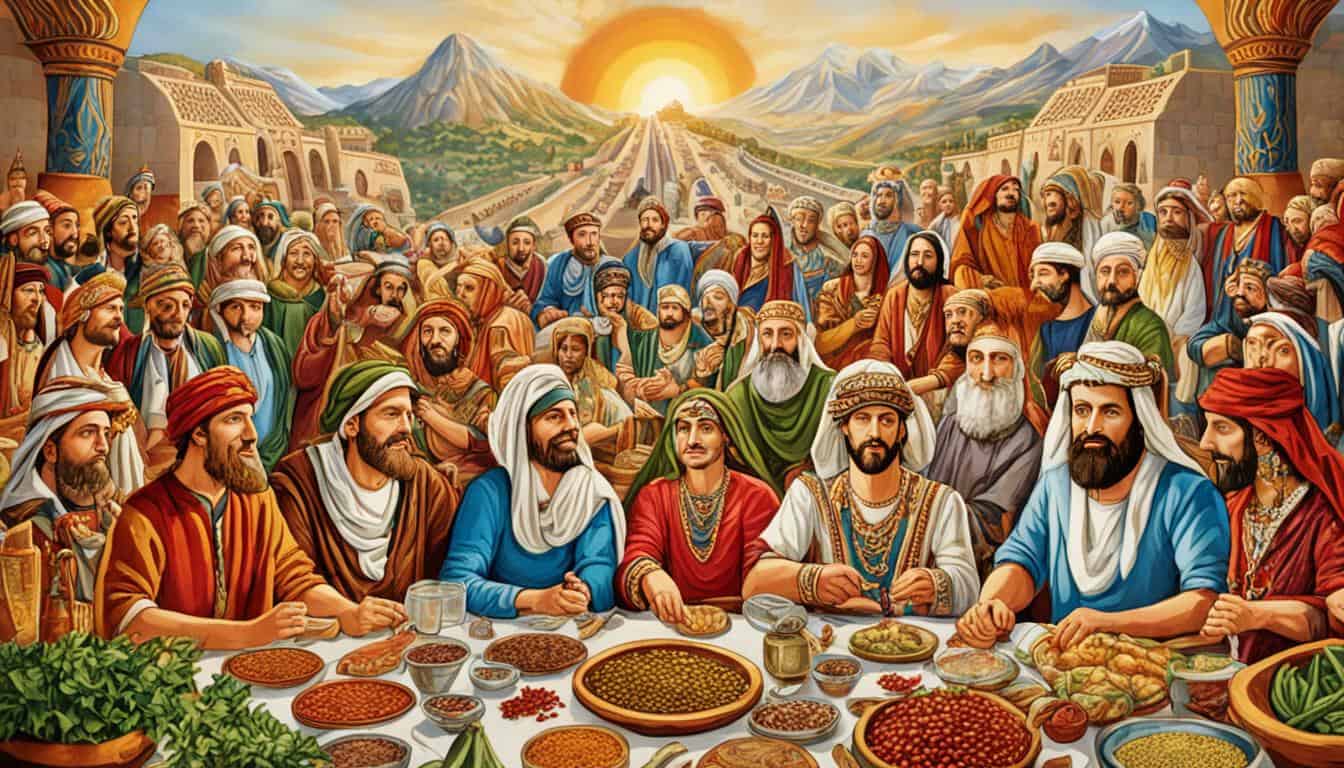Table of Contents
Did you know the Israelites took up many foreign customs over time? These included things like baal worship and borrowing words. These practices show us how deeply cultures interacted back then. Let’s look at ten intriguing practices the Israelites adopted.
Studying these customs helps us see how the Israelite culture developed. We’ll explore how they adapted to or changed these foreign practices. This will challenge what we commonly think and show their unique path.
Baal Worship (1 Kings 16:31)
In 1 Kings 16:31, we see a dark time in Israel’s history. This is when Baal worship became popular. King Ahab’s queen, Jezebel, from Sidon, played a big part in spreading it.
Jezebel made Baal worship a part of Israelite life. Even though the Israelites had a strong spiritual background, Baal’s appeal was too strong.
The move towards Baal worship changed Israel’s religious and cultural scene. Israel’s traditions started to mix with Baal’s rituals.
Worshipping Baal included very upsetting rituals, like sacrificing children. This was very different from the Israelites’ beliefs. They valued life over everything.
Sacrificing children for Baal went against what the Israelites stood for.
Many Israelites stood against Baal worship, despite Ahab and Jezebel promoting it. They stuck to their own traditions and didn’t fall for Baal’s influence.
Influence on Israelite Traditions
Baal worship really shook up Israelite society. They were torn between their age-old customs and the new appeal of foreign gods. This conflict lasted through their entire history.
But, the worship of Yahweh remained at the heart of Israelite faith. Their covenant with God kept them strong, despite Baal’s pull.
| Implications of Baal Worship | |
|---|---|
| Clash with Israelite traditions | Child sacrifice did not fit with the Israelites’ value of life. |
| Religious syncretism | Baal worship challenged Israel’s belief in one God. |
| Cultural exchange | Jezebel’s effect from Sidon mixed Phoenician culture with Israel’s. |
| Tensions and divisions | It caused split among Israelites, some defending their old ways. |
Studying Baal worship helps us understand Israel’s struggle to keep their culture. They fought to hold onto their unique identity, surrounded by different influences.
Golden Calves (Exodus 32:1-4)
When Moses went up Mount Sinai to get the Ten Commandments from God, the Israelites grew restless. They went back to their Egyptian ways and created golden calves. They saw these as images of God.

The golden calves quickly turned into idols for the people. They thought the statues had spiritual power. This shows how much the Israelites’ past in Egypt affected their faith. They were used to worshipping gods that looked like animals.
Seeing the idolatry, Moses was very upset. He broke the stone tablets God gave him, showing the people they broke His commandments. Moses knew God couldn’t be put into a physical shape.
“And Aaron said unto them, Break off the golden earrings, which are in the ears of your wives, of your sons, and of your daughters, and bring them unto me.” – Exodus 32:2
But even with Moses’ teaching, the Israelites kept at their idol worship. This is a story that warns us about the dangers of straying from the true God.
The Significance of Representation
The golden calves reveal our natural wish to see God in a physical way. Having a way to touch or see a sign of God comforts us. It makes God easier to understand.
But the Israelites made a mistake. They forgot what God is really like. Instead of focusing on His unseen, infinite nature, they worshiped something they could see and touch.
Moses: The Leader and Prophet
Moses was key here as the Israelites’ leader. He knew the importance of knowing and worshiping God correctly, without images. Breaking the golden calves showed his devotion to God’s commands.
The lesson here is to always seek a direct bond with God. Avoid looking for Him in things we can make or see.
| Key Points | Details |
|---|---|
| 1. The adoption of Egyptian practices | The Israelites, influenced by their time in Egypt, fashioned golden calves as representations of God. |
| 2. Idol worship and disregard for the Ten Commandments | The golden calves became idols, leading to the violation of God’s commandments and the destruction of the tablets. |
| 3. The significance of representation | Human nature’s desire for a tangible representation of the divine and the dangers of relying on physical idols. |
| 4. Moses’ role as the leader and prophet | Moses’ actions in destroying the golden calves and his commitment to upholding the commandments. |
Asherah Poles (Judges 6:25-26)
Some Israelites started using Asherah poles from Canaanite culture. People thought these poles symbolized a fertility goddess. They set up these wooden poles as signs of worship for the goddess Asherah. During Gideon’s time as a judge, he removed an Asherah pole devoted to Baal. Gideon took this action to show his loyalty to the true God and to avoid worshiping idols.
Bringing Asherah poles into Israel showed Canaanite influences in the society. Canaanites’ religious practices revolved around different gods and goddesses, including Asherah. By using Asherah poles, Israelites mixed their beliefs with those of the Canaanites.
“You shall not make for yourself an idol or a likeness of anything that is in heaven above, or that is in the earth beneath, or that is in the water under the earth.” – Exodus 20:4
Although Asherah poles were against Mosaic Law, their use highlights a struggle. Israelites worked hard to keep their traditions and faith separate from the nations around them.
| Aspect | Israelite Adoption of Asherah Poles |
|---|---|
| Influenced By | Canaanite Culture, specifically the worship of the fertility goddess Asherah |
| Significance | Believed to enhance fertility and promote agricultural abundance |
| Notable Figure | Gideon, who tore down an Asherah pole dedicated to Baal |
| Connection to Israelite Faith | Deviation from monotheistic worship prescribed by the Mosaic Law |
Human Sacrifice (2 Kings 3:27)
Ancient history is full of chilling tales. It tells of dark rituals and customs, some including acts beyond imagination. Human sacrifice, a gruesome tradition, has marked many civilizations. Even those like the Israelites, who stood by strong ethical beliefs, were sometimes tempted to this dreadful deed.
In the story of 2 Kings 3:27, King Mesha of Moab faced a tough situation. He was under siege by the Israelites. Desperate, he made a shocking choice. Against the laws of his neighbors, he sacrificed his firstborn on the city wall.
The aftermath of this act was severe and widespread. The thought of child sacrifice is troubling. Yet, it warns us of the extreme lengths some would go for power.
Noting that other cultures practiced human sacrifice doesn’t excuse King Mesha’s act. The Israelites’ laws prohibited such actions, showing their value for life above all else.
“Do not give any of your children to be sacrificed to Molek, for you must not profane the name of your God. I am the Lord.”
Israel’s ban on human sacrifice showed their dedication to high moral standards. It was a core part of their law, highlighting their respect for human life.
A Fatal Temptation
Despite finding human sacrifice against their beliefs, some Israelites were drawn to it. Cult practices and desperation could weaken even strong-willed individuals, as seen with King Mesha.
While facing the allure of other cultures, the Israelites’ commitment to their teachings protected them. It shows their society’s strength and unwavering values.
The Unending Battle
King Mesha’s human sacrifice is a stark reminder. It shows how easily respected societies can fall to darkness. This battle between right and wrong is a longstanding human struggle.
Talking about the Israelites’ choices shows deeper challenges. It’s not just about their victories over temptations but also the inner conflicts of maintaining their moral compass.
| Comparison of Human Sacrifice Practices | |
|---|---|
| Culture | Beliefs and Practices |
| Moab | King Mesha’s desperate human sacrifice on the city wall. |
| Israelite Law | Explicitly forbade human sacrifice, valuing the sanctity of life. |
Child Circumcision (Genesis 17:9-14)
Child circumcision is a key cultural and religious ritual for the Israelites. It links them to Abraham, their forefather. It also shows their dedication to God. This ancient ritual continues to be very important in Judaism.
This tradition starts with Abraham making a pact with God in Genesis 17:9-14. God tells Abraham to circumcise himself, his sons, and male servants on the eighth day of life. This covenant marks a sacred relationship between the Israelites and God.
“And ye shall circumcise the flesh of your foreskin; and it shall be a token of the covenant betwixt me and you.
And he that is eight days old shall be circumcised among you, every man child in your generations; he that is born in the house, or bought with money of any stranger, which is not of thy seed. He that is born in thy house, and he that is bought with thy money, must needs be circumcised: and my covenant shall be in your flesh for an everlasting covenant.” – Genesis 17:11-13
Abraham, seen as the Israelite nation’s father, gave high value to circumcision. It represents the covenant and the special bond between God and Abraham. This act’s importance is highly spiritual for them.
Through circumcision, the Israelites honor their traditions. It’s an outward emblem of their role as God’s chosen ones. It reminds them of their obligation to obey His laws through the ages.
Brit milah is the term for child circumcision in modern Judaism. It is done by a trained expert, known as a mohel, on the eighth day. The ceremony includes blessings, prayer, and the baby’s name. It marks the child’s membership in God’s covenantal community.
Child circumcision also offers health advantages. It lowers the risk of certain infections and diseases. Research shows it can prevent urinary tract infections, sexually transmitted diseases, and some forms of cancer in males.

In conclusion, circumcision is a visible sign of the sacred bond between God and the Israelites from Abraham’s time. It is a vital aspect of the Jewish faith. It reflects their devotion to their cultural legacy and their relationship with God.
Astrology (2 Kings 21:3)
Astrology was a foreign practice the Israelites took up during King Manasseh’s time. He was known for being wicked and not following Israelite customs. Astrology focused on the stars and signs, thought to influence people’s lives. This idea came from Mesopotamia, where they believed the stars controlled what happened on Earth.
“And he did what was evil in the sight of the Lord, according to the despicable practices of the nations whom the Lord drove out before the people of Israel.” – 2 Kings 21:2
During King Manasseh’s rule, astrology was all about your birth’s star placements. They thought the stars and planets could show someone’s future and what they were like. By looking at the stars, astrologers hoped to understand what the gods might be telling them.
King Manasseh was interested in astrology because Mesopotamia, his neighbors, saw it as very important. They were known for their knowledge of the stars and believed they could predict the future. This interest connected the Israelites with Mesopotamian beliefs.

The Influence of Mesopotamian Cultures on Astrology
Babylonians and Assyrians in Mesopotamia first developed astrology. They thought the stars and planets showed signs that could help predict events and guide personal decisions. Astrology was used for many aspects of life, including political choices.
King Manasseh taking up astrology shows how strong Mesopotamia’s influence was on Israel at the time. Everyone was interested in controlling their future. Hence, the Israelites turned to astrology for answers.
| Mesopotamian Astrology | King Manasseh’s Divination |
|---|---|
| Influenced by Babylonian and Assyrian astrological traditions | Adopted Mesopotamian astrological practices |
| Interpreted celestial omens to predict future events | Observed constellations and signs for divination purposes |
| Used in personal, healing, and political contexts | Sought guidance and insights through astrology |
When King Manasseh started using astrology, it mixed Israelite and Mesopotamian beliefs. This blend shaped Israelite religion and their spiritual views. It was a time of sharing and learning from one another’s beliefs.
Funeral Practices (Genesis 50:2-3)
Genesis 50:2-3 mentions how the Israelites practiced funerals. They would mourn and embalm leaders like Jacob. Though they borrowed embalming from the Egyptians, their ways were simpler. These customs were key in honoring the dead and helping families find peace.
Family and friends would gather to remember the deceased and take part in rituals. The length of mourning changed depending on the person who died and their connections. This time was crucial for those grieving.
The Israelites used embalming but not as intricate as the Egyptians. Unlike the Egyptians who focused on body preservation, the Israelites cherished remembering the dead through ceremonies.
“And Joseph commanded his servants the physicians to embalm his father. So the physicians embalmed Israel.”
Embalming also meant washing and adding perfumes to the body. This kept the body looking well during the mourning. It was a way for loved ones to have a last visit.
After preparing the body, it was covered in nice fabric. Then, how they were laid to rest depended on family traditions. Everyone coming together during the burial showed support for the grieving.
These funeral customs showed respect, offered comfort, and remembered the life of those lost. Today, many cultures still rely on these practices when someone passes away.

Funeral Practices Table
| Funeral Practices | Characteristics |
|---|---|
| Mourning Period | Changed in length based on status and relationships. It helped honor the dead and comfort families. |
| Embalming | Includes washing and using oils. It prepared the body for the burial and allowed goodbyes. |
| Burial | The body was placed in a coffin or a tomb. It was a time for the community to support the family. |
War Chariots (Judges 1:19)
The Israelites learned the power of chariots from the Canaanites. Even though they mainly fought on foot, they saw how chariots changed battles. So, they started using chariots too.
The Canaanites were famous for using their war chariots well. Their quick chariots struck fear and awe in those who faced them.
Seeing this, the Israelites adjusted their military ways. They added chariots to their forces. This move helped them fight better, move easier, and get ahead in battle.
War chariots gave the Israelites a new way to win battles. They could move fast and hit their enemies hard, changing the game.
Even though they were mostly ground fighters, the Israelites valued chariots. This choice showed their smartness. They took what they saw work and made it work for them too.

Advantages of War Chariots for the Israelites:
- Increased mobility
- Enhanced striking power
- Improved maneuverability on the battlefield
- Tactical versatility
- Intimidation factor against enemy forces
The Israelites showed their skill by adding chariots to their warfare. This proved they could change and adapt to win battles.
| War Chariots: Israelites vs. Canaanites | Israelites | Canaanites |
|---|---|---|
| Primary Forces | Foot Soldiers | Foot Soldiers and War Chariots |
| Mobility | Initially limited | Enhanced with chariots |
| Battlefield Presence | Less intimidating | Chariots provided a significant advantage |
| Tactical Advantage | Gained through chariot adoption | Utilized chariots effectively |
Multiple Garments (2 Samuel 13:18)
In ancient Israel, clothes showed more than just what people wore. They were signs of your place in society. The rich often wore layers of clothes to show the world they had wealth. This was likely inspired by the fancy fashion of nearby Mesopotamia.
While most wore a single layer, wealthy folks in Israel put on many garments. This was their way of telling everyone that they were rich and important. Wearing lots of clothes was like wearing a badge of honor.
The use of multiple garments allowed the wealthy Israelites to stand out and make a bold fashion statement.
The clothes of the wealthy were not ordinary. They were made using special fabrics like linen and silk. These materials were then dyed in colors that stood out and were decorated with fancy designs. This showed how much the wearer valued beauty and luxury.
Wearing several pieces wasn’t just about looking good. For the wealthy, it was their way of being part of a bigger cultural exchange. They borrowed style tips from Mesopotamia, showcasing an open-minded view of the wider world.
By mixing Mesopotamian styles with their own, rich Indians showed their worldly attitude. This mix of different cultural influences demonstrates how, even in ancient times, civilizations were connected through shared customs.
So, wearing many clothes wasn’t just fashion for the wealthy in Israel. It was a way to display their riches and to show they understood and welcomed different cultural flavors.

| Benefits of Multiple Garments for the Wealthy Israelites | Reasons for Adoption |
|---|---|
| Enhanced social status and prestige | The wealthy Israelites used multiple garments to visually distinguish themselves from the common people, solidifying their position in society. |
| Expression of wealth and opulence | Through their elaborate and intricately designed garments, the wealthy Israelites showcased their prosperity and elite status. |
| Cultural borrowing and cosmopolitanism | The adoption of Mesopotamian fashion trends allowed the wealthy Israelites to demonstrate their cultural awareness and openness to diverse influences. |
| Personal expression and style | Wearing multiple garments provided an avenue for self-expression, allowing the wearer to showcase their unique fashion sense. |
Language Borrowing
Hebrew has a rich history of language borrowing. It took in words from languages nearby, such as Aramaic and Phoenician. This process made Hebrew’s vocabulary more interesting.
Long ago, the Israelites met many cultures through trade. This led to them using words from these other languages. Aramaic, a language close to Hebrew, left a big mark. This was because it was widely spoken in the Near East. Words from Aramaic are common in both religious and everyday Hebrew. They remind us of ancient cultural connections.
Sharing words is just part of culture mixing. The Hebrew language grew by embracing the neighboring languages. This happened through business, cultural ties, and political agreements.
The Phoenicians, who spoke Phoenician, played a role too. They were famous for sailing and trading. This made their language important in Hebrew for topics like ships and business terms.
Throughout time, this cultural exchange not only added to Hebrew’s words but also to how it structures sentences. It shows how interconnected ancient people were. Plus, it highlights how languages are always changing.
Examples of Language Borrowing in Hebrew:
| Neighboring Language | Hebrew Word | Meaning |
|---|---|---|
| Aramaic | כְּתָב | writing |
| Aramaic | צִדְקָה | charity |
| Phoenician | סַפִּינָה | ship |
| Phoenician | מַטְעֵן | cargo |
Words borrowed from Aramaic and Phoenician make Hebrew more lively. They connect us to the ancient world. And they keep the historical stories in Hebrew texts alive.

Conclusion
Throughout history, the Israelites mixed various foreign ways into their culture. This reflect how they connected with other societies. For example, they started to worship Baal because of King Ahab and Jezebel. They also used golden calves to represent their God. Both of these changes were from the influence of nearby cultures.
Additionally, they started to use Asherah poles and even did human sacrifices. This showed how they mingled with Canaanites. They also did things like child circumcision, astrology, and certain burial rites. The adoption of war chariots and wearing lots of clothes reflected their openness to new ideas from other places. By borrowing languages, they further deepened their cultural ties over time.
Looking at these ten foreign ways gives us a richer view of Israelites’ history. It shows how they blended their traditions with those of others. These foreign elements not just changed their faith but also their daily ways and traditional practices.




